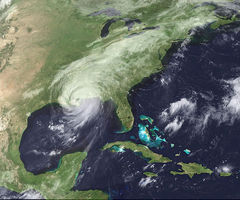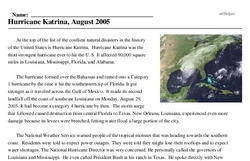Hurricane Katrina, August 2005
At the top of the list of the costliest natural disasters in the history of the United States is Hurricane Katrina. Hurricane Katrina was the third strongest hurricane ever to hit the U. S. It affected 90,000 square miles in Louisiana, Mississippi, Florida, and Alabama.
The hurricane formed over the Bahamas and turned into a Category 1 hurricane by the time it hit the southeastern tip of Florida. It got stronger as it traveled across the Gulf of Mexico. It made its second landfall off the coast of southeast Louisiana on Monday, August 29, 2005. It had become a category 4 hurricane by then. The storm surge that followed caused destruction from central Florida to Texas. New Orleans, Louisiana, experienced even more damage because its levees were breeched, letting water flood a large portion of the city.
The National Weather Service warned people of the tropical monster that was heading towards the southern coast. Residents were told to expect power outages. They were told they might lose their rooftops and to expect water shortages. The National Hurricane Director was very concerned. He personally called the governors of Louisiana and Mississippi. He even called President Bush at his ranch in Texas. He spoke directly with New Orleans mayor Ray Nagin. Nagin issued an evacuation order for his city. Most people left. About eighty percent of the population evacuated. The estimate was that around 100,000 people remained in the metro area. Some were stranded tourists; others did not own a car and had no way out. Those who were not able to leave were instructed to go to the New Orleans Convention Center and the Superdome.




